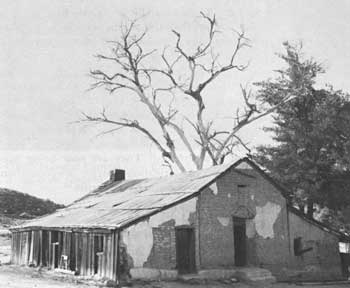






Survey of Historic Sites and Buildings
 |
WARNER'S RANCH California |
 |
| ||
Ownership and Administration. Various private owners.
Significance. Although famous as a way station for almost all pioneers entering southern California over the Gila Trail and as a Butterfield Overland Mail stage station, Warner's Ranch was also a pioneering cattle ranch.
Jonathan Trumbull Warner, a native of Connecticut, in 1830 joined a trading party bound from St. Louis to Santa Fe. The following year he accompanied a party of fur trappers to California, where he spent 2 years trapping beaver. From 1834 to 1841 he operated a store in Los Angeles, by which time he had become a naturalized Mexican citizen and changed his name to Juan Josè Warner. In 1844 and 1846 he obtained two land grants from the Mexican Government. These grants totaled about 44,322 acres and were located in what is now eastern San Diego County. In 1845 Warner built a two-room adobe house with thatched roof on his new estate, at the Indian village of Agua Caliente, now known as Warner's Hot Springs.
 |
| Warner's Ranch, California, was the stopping place for forty-niners bound for the goldfields on the southern trails. Pictured here is the adobe ranchhouse Warner erected in 1849. |
Because of the influx of travelers over the Gila Trail in 1849, Warner moved from the house at Agua Caliente about 4 miles to the south, where he erected the adobe ranchhouse that still stands, as well as a store to trade with the immigrants. Warner resided at this location until 1857, when the U.S. District Court reawarded one of his claims, Rancho Agua Caliente, and his house to an earlier claimant of the land. Warner then moved to Los Angeles. From 1858 to 1861, his former home served as a stage station on the Butterfield route. In 1861 by mortgage foreclosure Warner lost the other portion of his ranch to John Rains, capitalist and cattle baron of Los Angeles and San Bernardino Counties. Rains moved up his vast herds of cattle from his ranches at Chino and Cucamonga, and the Warner property became a great ranch.
Present Appearance. A part of the original ranch land has been covered by Lake Henshaw, but most of the remaining part is little changed from the way it appeared in 1849. Private cattle raisers have leased the valley. At the ranch headquarters are the remains of two original adobe structures, Warner's ranchhouse of 1849 and a barn erected in 1858. Both of these structures have been partially covered with weatherboard. They are now being preserved and restored by the Vista Irrigation District, in cooperation with several historical societies of southern California. [10]
NHL Designation: 01/20/61
 |
 |
http://www.cr.nps.gov/history/online_books/prospector-cowhand-sodbuster/siteb7.htm
Last Updated: 22-May-2005